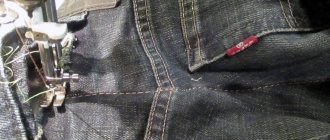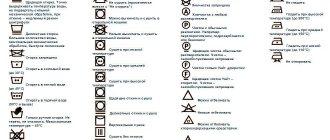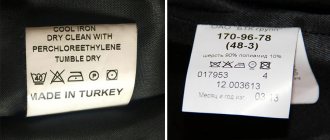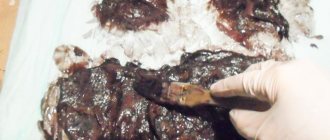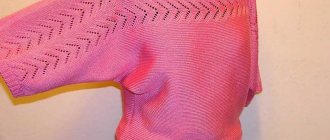Machine wash jackets on a delicate cycle using gel or liquid detergents. Draw warm water 30–35˚С. Avoid twisting and drying in the sun. Dry on hangers and iron through gauze or using a steamer. Use dry cleaning with salt, soda, starch, sand. To remove grime and stains, use rubbing alcohol or ammonia.
Washing jackets: school jackets, suit jackets, women's jackets is a labor-intensive process and requires knowledge of the characteristics of cleaning the fabric from which the product is made. To avoid damaging the item, read the information on the label before washing and use only the washing, cleaning and ironing methods approved by the manufacturer.
Stain removal technique
Before washing your jacket, carefully examine it for stains. Remove dirt using improvised means:
- remove chewing gum from the fabric after freezing the item;
- Wipe stains from paint or corrector with turpentine, thinner or purified gasoline;
- any hair shampoo will help get rid of stains left by natural juices: strawberry, cherry, tomato;
- Remove stubborn oil stains with dishwashing detergent;
- Wipe off coffee marks with a cotton pad soaked in ammonia.
To prevent damage to the jacket, before treating the stained area, test the chosen method on a small strip of the product that is inaccessible to view (on the wrong side or on a special piece of fabric, if one came with the jacket when purchased).
Typewriter
Can a jacket be washed in a washing machine? There are models for which mechanical processing is strictly contraindicated. After this wash, you can simply throw them away.
Therefore, before washing a jacket in a washing machine, you need to study the instructions on the label and then proceed with the procedure, if possible.
If such manipulation is prohibited, the tag will have a round icon with a washing machine drawn inside it. A basin with water and the temperature of the liquid should also be drawn.
The answer to the question of how to wash a men's jacket is quite simple. Before the procedure, you must check all pockets for foreign objects, turn the product inside out and remove stains.
How to properly wash a jacket:
- You need to put several products into the drum. 2-3 suits can be washed at once.
- The door of the device is then closed and a gel-like detergent is poured into the container. It rinses out better.
- Jackets are washed on a delicate cycle or manually. Processing a suit in a washing machine with a different cycle setting, for example, jeans, will only ruin it, but it will not wash it better.
- You cannot dry such products in a machine.
Corduroy items should not be subjected to such treatment. Woolen items may shrink when machine washed, so it is recommended to clean them using the wet method.
If done incorrectly, jackets that cannot be machine washed can become deformed.
You should not skimp on dry cleaning if the item is wool. Only professionals in their field work in such establishments and know how to properly wash a jacket so that it looks like new and does not become deformed.
Machine washable
Washing a jacket in a washing machine
Wash out stains. Treat worn and greasy areas with an aqueous solution of ammonia or a mixture of medical alcohol and ammonia.
When choosing a detergent, choose liquids: gels, capsules, liquid powder or soap. A small amount of fabric softener helps with ironing the item.
Set the washing mode to gentle. Delicate wash is optimal, hand wash is an option. The temperature during washing should not exceed 40˚C. Turn off spin or select minimum speed.
We use the shower
If the jacket has to be washed frequently, this can cause it to lose its appearance and stretch. To prevent this from happening, you can wash it in the shower; you will get a fairly gentle washing cycle.
Follow the recommendations provided and everything will work out:
- shake off dust from the product;
- hang it on a hanger in the shower or bathtub;
- turn on warm water, it should not be hot;
- pour the jacket on both sides;
- prepare a cleaning solution using a detergent suitable for the type of fabric;
- moisten a soft brush in the prepared solution and treat the item with it;
- pay special attention to very dirty places;
- turn on the water and rinse off the detergent;
- do not remove clothes from hangers or twist them, let them dry in the same form as they were washed;
- There is no need to iron the product after such washing, unless it remains too wrinkled.
Hand wash
If the product is not machine washable, it will have to be washed by hand.
Hand wash jacket
Before washing your jacket, leave it in cool water, adding your chosen liquid detergent to the water in advance.
Important! Jackets made of delicate fabric should not be soaked.
After an hour after soaking, start washing in slightly warmed water (30–35˚C). You should not rub or twist vigorously, as this will damage the item. Movements should be light and neat.
After washing, take out the jacket, hang it vertically and rinse with plenty of cool running water. Cold water will prevent clothes from shrinking.
Preparation
Proper preparation means avoiding problems at the end of the process. Check your pockets first. Even if there is nothing valuable there, the remains of forgotten pieces of paper will become limp and at the end of the day the entire washed item will be in white shreds, so take everything out completely.
Greasy parts of clothing include elbows, cuffs, collar and pockets. Before machine or hand washing, you need to additionally treat with detergent. It is applied to the stain and left for an hour, after which further washing is carried out. Ammonia is used for these purposes, but it is not suitable for all types of fabrics - before use, check it on an inconspicuous area of the item (for example, on seam allowances).
Features of drying and ironing
Drying and ironing the washed item plays an important role.
How to iron a jacket correctly
This determines whether the jacket will retain its shape and aesthetic appearance.
Since the jacket is a delicate item and cannot be wrung out, drying will take a long time. Dry properly on hangers or horizontally at room temperature.
Note! Drying outside is allowed, but you should avoid exposure to sunlight to protect the item from fading.
When the jacket is slightly dry, begin ironing. Place cotton or gauze cloth between the fabric and the iron. This will prevent stains from forming on the material.
A steam iron is used to iron in a vertical position, without touching the item (non-contact).
Dry cleaning
A jacket or cardigan should be cleaned once every 2 weeks. If it is not possible to wash the material, then it would be best to use dry cleaning services. This method has a number of advantages:
- less fabric wear even with frequent processing;
- deep cleaning of all layers;
- No need to waste time doing laundry yourself.
The main disadvantage is the cost of the service, but a good jacket is also not cheap. It is advisable to have it dry cleaned periodically to preserve the appearance of the item longer.
Dry cleaning
Dry cleaning is a gentle cleaning method.
Cleaning with a sticky roller
No soluble auxiliary substances are required, which significantly saves the product.
With this method, the following equipment is used:
- adhesive roller (you can use tape);
- clothes brush with natural bristles;
- natural ingredients (salt, soda, starch, sand).
After cleaning, you need to dry and ventilate the item.
Wet cleaning
This is a less gentle but more effective cleaning method. Allows you to get rid of unpleasant odors, dust, and dirt.
Quick cleaning method
Using a spray bottle or a moistened sponge, apply a cleaning agent to the jacket:
- dissolved vinegar or ammonia;
- soapy water;
- special stain remover.
After cleaning, the jacket should be ironed immediately, placing gauze between the iron and the item.
Cleaning a leather product
The skin has strength and elasticity.
Manual wet cleaning only
Washing this material is contraindicated, but wet treatment will help clean the surface of the jacket.
To do this, prepare an aqueous solution containing a copious amount of soap and ammonia. We use a sponge soaked in it to treat the stained areas and dry them with a soft cloth or cotton pads.
Gasoline or turpentine will help remove stubborn greasy stains. It is enough to wipe the necessary areas with a cloth soaked in them.
Advice! To give the leather its former shine, lubricate the jacket with Vaseline, lemon juice or egg yolk.
Washing a wool jacket
To find out whether wool jackets can be washed in a washing machine, you should read the contents of the label. Often such washing is contraindicated.
Read the label before washing
Woolen and half-woolen items can only be washed by hand and in cold water, since the fabric becomes deformed upon contact with hot water.
To make the item last longer, before each wear you should take time to clean the jacket with a clothes brush. It will remove dust particles and particles of dirt from the fibers, which will allow you to resort to washing less often, which means maintaining the aesthetic appearance of the item longer.
How to remove a stain from a suit
To remove a stain without a trace, you need to correctly determine its origin and fabric composition.
Begin removing dirt by shaking out and cleaning. Before applying the stain remover to clothing, check the interaction of the solution and the material in an inconspicuous place. If the stain is small, you can apply the product using a pipette.
- To remove a fresh grease stain, sprinkle it with salt and rub lightly. The procedure is repeated several times until the contamination disappears. Oily traces can be removed from a silk product with salt diluted in an ammonia solution.
- Before removing traces of soot, the dirty area is degreased, then treated with pine turpentine and blotted with a soft cloth. Then rub the stain with a brush and soapy water and wash with warm water. In case of severe contamination, replace the powder with egg yolk.
- To remove traces of fruits and berries, use hot milk or water, as well as a solution of hydrogen peroxide. Dissolve 5 ml of hydrogen peroxide in 100 ml of water, treat the stain and wash off in cold water.
- Rust is removed by treating the dirty area with a cotton swab dipped in a 10% solution of tartaric or citric acid. Then rinse with cold water.
- There are several recipes for removing traces of iodine:
- Using a solution of ascorbic acid. To do this, take 5 ml of warm water (1 tsp) and dissolve a vitamin C tablet in it, apply it to the dirty area. After a few minutes, not a trace remains of the stain.
- In case of significant contamination, the amount of ingredients is increased. Using alcohol or milk. The dirty area is moistened several times, and then the item is washed.
Recommendations for washing a suede jacket
It is recommended to clean products made of suede or nubuck by heat treatment with steam, then, without waiting for drying, treat with a rubber brush.
Stains can be cleaned with a sponge moistened with ammonia or a solution of a glass of low-fat milk and a teaspoon of soda.
Steam treatment
You can also purchase special products for this fabric - for details, see the material “How to remove greasy stains from suede.”
Dry a suede jacket in a horizontal position.
How to dry a jacket correctly
In addition to proper washing, the drying process is also important, because an incorrectly dried product can lose its appearance.
After washing and drying, the jacket can be given a neat look by ironing
The basic rule is that you should not wring out the item; the water should drain on its own. To do this, hang the jacket on hangers over the bathtub. The item should not be placed vertically, otherwise folds and creases may form.
When drying in the fresh air, it is important that the product is not exposed to direct sunlight. If the jacket is left in the bathroom to dry, it is important that the door is open.
If ironing is required, it is performed at a time when the fabric is not yet completely dry. The jacket should be ironed through gauze to prevent the appearance of a shiny sheen. If the product is completely dry, use the steam function. After smoothing, the jacket is put back on the hanger.
Advice! If you have a vertical or manual steamer, then it is better to use it for smoothing, as it allows you to eliminate almost all formed wrinkles.
Cleaning the collar and lapels
To clean one of the most contaminated areas of the product, you can use one of the following methods:
- Dissolve salt and ammonia in a ratio of 1:6. We wet the sponge and treat the collar.
- We dilute ammonia in water in a ratio of 1:3. Use the resulting mixture to wipe off any dirt. Wipe the treatment area with a cotton pad soaked in heated water.
- Clean the required surface with a disc soaked in vodka or medical alcohol. Then iron until completely dry.
Material on the topic: How to clean greasy stains on a down jacket.



